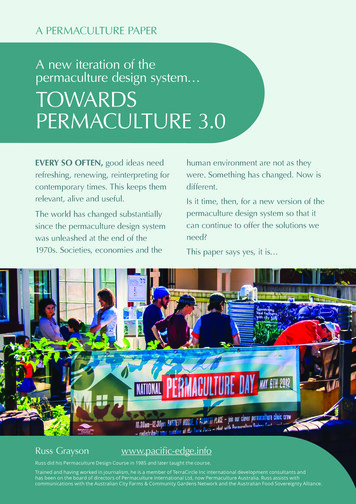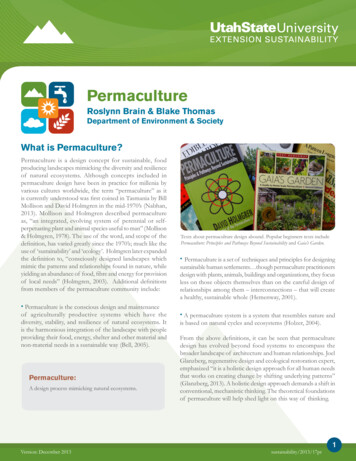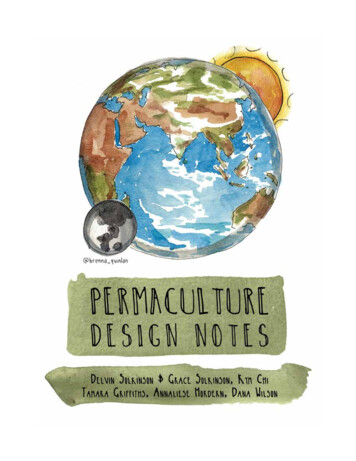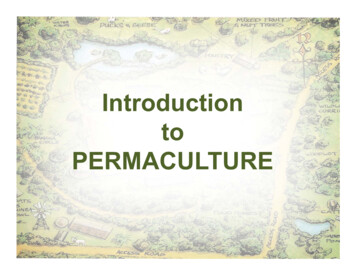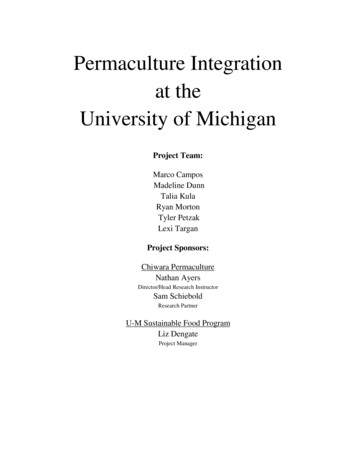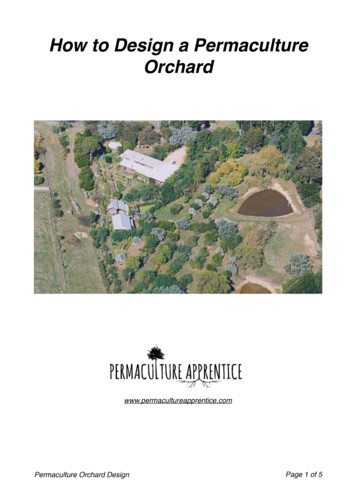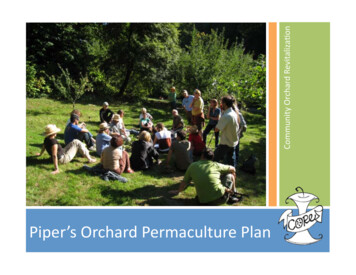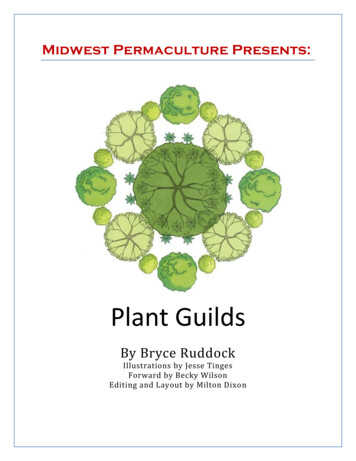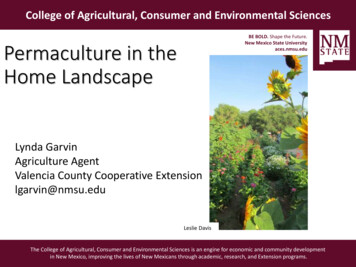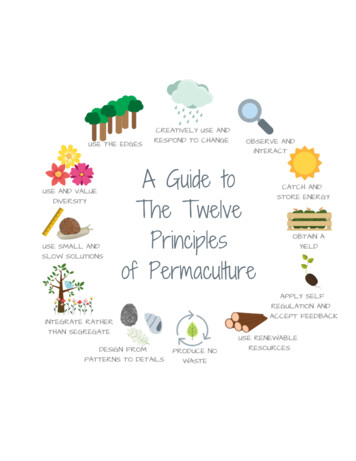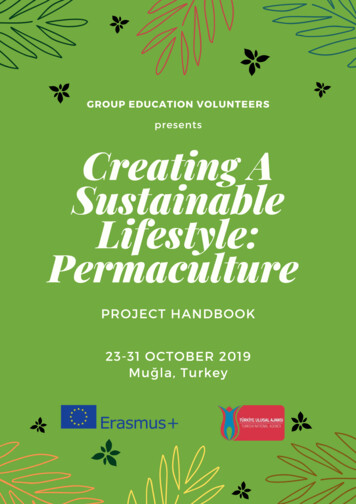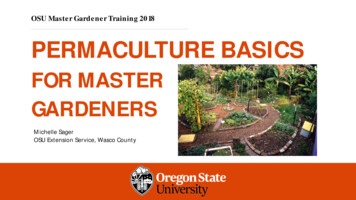
Transcription
OSU Master Gardener Training 2018PERMACULTURE BASICSFOR MASTERGARDENERSMichelle SagerOSU Extension Service, Wasco County
Learning Objectives1. Understanding of foundations of Permaculture2. Examples of Permaculture design techniques for backyard gardensa. Including some controversial ideas in Permaculture3. Familiarity with at least one Permaculture design principle4. Practice at designing / applying principlesOREGON STATE UNIVERSITY1
OREGON STATE UNIVERSITY2
What is Permaculture?OREGON STATE UNIVERSITY3
What is Permaculture?Permaculture is most oftenused for creating efficientand productive landscapesthat sustain themselvesinto the future byregenerating biodiversityand lost fertility.OREGON STATE UNIVERSITY4
Permaculture EthicsCare for the EarthOREGON STATE UNIVERSITY5
Philosophy DesignOREGON STATE UNIVERSITY6
What is an Ecosystem?A system, or a group ofinterconnected elements,formed by the interaction of acommunity of organisms withtheir environmentOREGON STATE UNIVERSITY7
Philosophy DesignApplied EcologyEdible RestorationPermacultureRegenerative DesignCultivated EcosystemsOREGON STATE UNIVERSITY8
“Permaculture Design is not the rain, the roof, orthe garden. Permaculture Design is the connectionsbetween these things. Permaculture bringscohesion where there was once isolation.”-Bill MollisonOREGON STATE UNIVERSITY9
Inputs and Outputs ActivityOREGON STATE UNIVERSITY10
“You don’t have a snail problem you have a duck deficiency!”- Bill MollisonOREGON STATE UNIVERSITY11
The problem is the solution!OREGON STATE UNIVERSITY12
Design Principles Make connections. Catch and store energy andmaterials. Stack functions. Make the least change for thegreatest effect. Use small-scale, intensive systems.OREGON STATE UNIVERSITY13
Design ExamplesOREGON STATE UNIVERSITY14
Design Aims: Grow as much food as possible Provide food and habitat for beneficial critter friends Waste is put back into the system Build soil and store water Go with the flow (the problem is the solution!) Soil, sun, water, plants, wildlife OREGON STATE UNIVERSITY15
Food Forests Vertical stacking of treesand plants Creates microclimates High biodiversityOREGON STATE UNIVERSITY16
OREGON STATE UNIVERSITY17
OREGON STATE UNIVERSITY18
Hedgerows / Living Fences Defines boundaries / edges Water stored in biomass Edible possibilities (Fedge!) Noise reduction Windbreak Soil Stabilization Wildlife Corridor Attract beneficial insectsOREGON STATE UNIVERSITY19
OREGON STATE UNIVERSITY20
OREGON STATE UNIVERSITY21
OREGON STATE UNIVERSITY22
OREGON STATE UNIVERSITY23
GuildsGroup of plants chosen to help each other: attract beneficial insects deter wildlife fertilize mulch produce nectar to attract pollinators repel pests suppress grassOREGON STATE UNIVERSITY24
OREGON STATE UNIVERSITY25
Dynamic AccumulatorsFact or Fiction?What we do know: Phytoaccumulation does happenWhat we don’t know: If the plant will make those mineralsavailable to the soil and if they do,how long will it take?OREGON STATE UNIVERSITY26
CherryComfreyGarlicChivesOREGON STATE UNIVERSITY27
Three SistersNorth American Traditional Corn Beans SquashOREGON STATE UNIVERSITY28
HugelkulturOREGON STATE UNIVERSITY29
Fact or fiction?OREGON STATE UNIVERSITY30
Bioswales Farm-scale Sunken Flat bottom – on contour Designed to:capture and slow waterOREGON STATE UNIVERSITY31
Urban Bioswales Sunken Flat bottom – on contour Designed to: capture and slow water filter urban pollutantsOREGON STATE UNIVERSITY32
ImperviousSurfaces Do not allow rainwater toinfiltrate or soak into soil Concrete, roofs, driveways,sidewalks, roads, etc. Severe compaction fromheavy equipment or foottrafficOREGON STATE UNIVERSITY33
OREGON STATE UNIVERSITY34
Rain Gardens Sunken, flat-bottomed gardenbed Collects and treats stormwaterrunoff from rooftops, driveways,sidewalks, parking lots, andstreets mimic natural forest, meadow, orprairie conditions Filters out urban pollutantsOREGON STATE UNIVERSITY35
OREGON STATE UNIVERSITY36
OREGON STATE UNIVERSITY37
OREGON STATE UNIVERSITY38
OREGON STATE UNIVERSITY39
OREGON STATE UNIVERSITY40
African Keyhole DesignOREGON STATE UNIVERSITY41
OREGON STATE UNIVERSITY42
OREGON STATE UNIVERSITY43
OREGON STATE UNIVERSITY44
OREGON STATE UNIVERSITY45
Herb Spiral Many microclimates Hot on south side, cool on north side Drier at the top, moist at the bottom Vertical designOREGON STATE UNIVERSITY46
ObservationThe HEART of Permaculture design!OREGON STATE UNIVERSITY47
Observation What kind of soil do I have? Is it all the same? Where in my yard gets the most sun? The least? Where does water flow in my yard? Where does it puddle? Which direction does the wind come from? Which plant species are growing naturally here? Which wildlife friends visit my yard? through the day and through the seasonsOREGON STATE UNIVERSITY48
Site Analysis Design AimsOREGON STATE UNIVERSITY49
Design Aims: Grow as much food as possible Provide food and habitat forbeneficial critter friends Waste is put back into the system Go with the flow (the problem isthe solution) Soil, sun, water, plants, wildlife OREGON STATE UNIVERSITY50
“Permaculture Design is not the rain, the roof, or the garden. Permaculture Design is the connections between these things. Permaculture brings cohesion where there was
